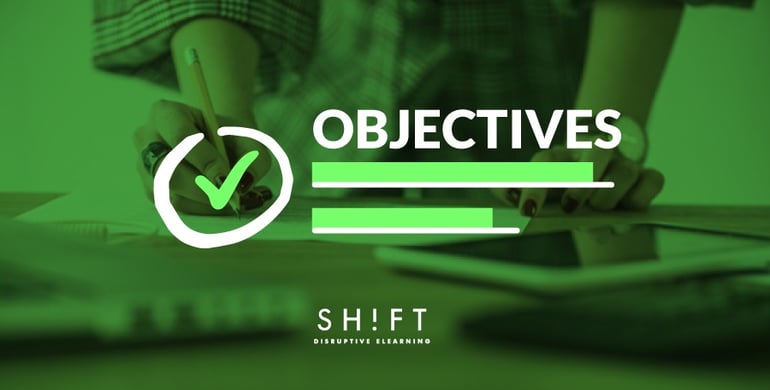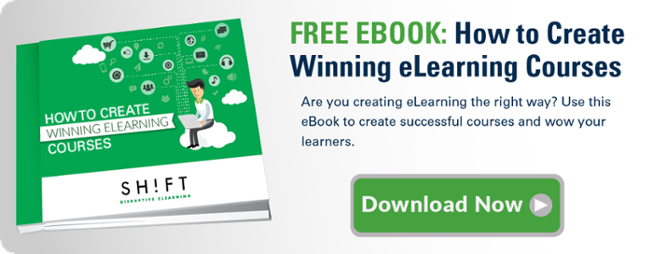The key to the learning is making the process feel easy. The key to making it feel easy is creating a roadmap that covers points in a straightforward and purposeful matter.
Think about it. You are creating this particular eLearning course because there is a need for it (hopefully you did a Needs Analysis first!). Learners are eager to acquire the skills and know-how, to change specific behaviors and advance in their everyday abilities.
Having learning objectives is providing direction to your students! Creating an eLearning course without defining these first, is like walking in the woods without a compass. Sooner or later, you'll get lost!
The art of writing objectives isn't hard to master. We've put together the following tips to help guide your writing journey and ensure successful eLearning courses.

Tip #1) Answer this: Why Are We All Here?
To begin, answer this: Why do employees or students need to take this course? Identify the value that comes to both parties because of it.
Are you training employees in a new process? Are you teaching them to address a specific task? Will they need a new skill or are you looking to change a behavior? Knowing the purpose of the course and what values come of it will give you direction and help you select content. Also, your learners will find purpose in your courses and are motivated to take these.
For students to stay motivated during the learning journey will require a sense of achievement. Without a learning objective, it’s hard to verify that your efforts are directed at a goal.
Also, if the learner is to acquire a new skill, it’s important to remind students WHY they are taking the course. Letting them in on the objective is incredibly motivating!
Tip: It can be as simple as identifying a set of tasks that the learner was not able to carry out before the course and will now complete successfully when finishing the course.
Struggling identifying learning objectives? Read this article.
Also read: How to Design eLearning That Meets Business Goals
Tip #2: Above All, Develop Learning Objectives that Are Measureable
Writing objectives that quantify or at least suggest an indicator of progress is key.
For example, if your goal is to teach an employee how to successfully address a customer service issue, what are the basics steps to this process? Create a bulleted roadmap of the process. Consider the questions that come along the way.
When writing down the objectives, take note that it must be an action that you can observe, or at least track easily.
Measurable objectives will give the learner two things: a sense of little victories along the way and the confidence that what they are learning is applicable immediately. And at the same time, they will give you (the trainer) a way to determine if the student actually fulfills the objective.
Tip: Align the objectives to BEHAVIOR. This is the key to creating specific and measurable objectives. Learn what learners will be expected to perform (read; the behaviors they will exhibit) when they get back to their jobs. Use these insights to create objectives that align with these observable behaviors. This keeps the training realistic and establishes relevance. Use verbs that aid measurability. For instance, instead of using vague and intangible words like “understand” or “appreciate,” use action verbs like “build,” “calculate,” “assemble,” or “diagnose.”
Check out this helpful guide to learn how to make objectives measurable.
List of Measurable Verbs Used to Assess Learning Objectives
Tip #3) Always Align Objectives - Activities - Assessments
Clear learning objectives are the fundamental tool that determine all planning and strategic decisions of building a course. They serve as the basis of anything you do. Therefore, you must use your objectives to select activities and assessments. This is called backward design.
How it works? First, you draft the objectives after taking into consideration what your target audience is supposed to learn or be able to do after taking the course. Then, you formulate learning activities that will make the learners apply their newly-acquired knowledge to answer questions or solve problems that they are likely to face in real life. Finally, you design assessments so that they map with the objectives and lets you figure out if the learners have imbibed what they had set out to learn.
Questions to consider are:
- Learning objectives: What do you expect students to learn and do after completing the course?
- Assessments: How will we know if students have achieved the desired results? What tasks will determine whether students have achieved their goals for each lesson?
- Instructional strategies: What type of activities will support my learning objectives and prepare students for an upcoming assessment?
Much like instructions, your learning objectives can be amazing, but they aren’t used, they aren’t relevant. If assessments are not aligned with learning objectives or instructional strategies, it can undermine both student motivation and learning.
When learners see that the instructional content, learning activities, and the assessment match the tasks they are expected to perform after completing the course, they find it meaningful and thus feel more motivated to carry on.
Tip: Let Bloom's Revised Taxonomy guide you. As eLearning designers, we are all familiar with Bloom's Taxonomy that lists the various types of cognitive tasks (the levels of learning) learners are expected to perform while taking the course. Bloom's Revised Taxonomy takes it a step farther and introduces types of knowledge that can be mapped to the levels of learning. So, you now have a dashboard of sorts, where you can create a holistic view of the learning objectives, the instructional content, and the assessment. You know immediately if there is any mismatch!
Also read: Alignment Should Always Be Our Watchword in eLearning
Tip #4) Zooming In On Language
Taking care of your verbs is important in everyday communication. This is especially relevant for course development. Your verb usage will set the tone for your course.
Using verbs that describe EXACTLY what your audience will be able to do upon completion will make them feel more confident to move forward.
So, here’s a tip: It’s best to stay away from emotionally inclined words or phrases such as: appreciate, become familiar with, and comprehend. They are a little vague and lack a bit of confidence.
Instead use specific words like: compile, select, utilize, prepare, explain, and apply. They are clearer and seems more instructive, leaving less room for interpretation.
The reason for this is that your learner may be touching on tasks that they find mildly intimidating and being clear and precise will extract a little doubt from the process.
Also read: Are You Writing Rockin’ Course Objectives? 7 Do’s and Don’ts
So, though many consider writing learning objectives to be a difficult task. It’s not. It’s a matter of getting the right information down and carefully planning how to pass this on to your students. If you are clear about why you’ve created this course and why they have been invited to take it, this writing experience can be a positive one and could serve as an example for courses to come.


